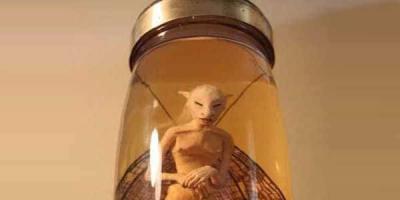Do fairies really exist? These are typical questions that arise for anyone who does not believe in the existence of supernatural creatures. Some of the modern "believers" claim that fairies are spirits that monitor the growth of plants. Is it so? Do you believe in the existence of fairies? Most of us answer no quite emphatically. The idea of fairies is so absurd that we even use the expression “fairy tales” when talking about something that we consider to be an outright lie.
Humans and fairies are creatures of different worlds. Fairies are invisible intelligent beings, and the fairy world is "an invisible world in which the visible world is immersed like islands in an unexplored ocean." These intelligent, mobile spirits have a body that glows and changes (similar to those called “astral”) and the consistency of a thick cloud; best visible at dusk. Their bodies are quite changeable due to the refinement of the spirit that inhabits them; they can disappear or appear at will.
Fairies passionately love music and have unique talents to perform magical melodies that no human heart can resist. It is not stormy, not passionate, it is the music of an exiled spirit, yearning, yearning, foggy and restless; he is always looking for the unattainable, he is always in the shadows, filled with memories of some lost good. If people happened to hear the music of fairies, then they became not the same as before and became possessed, practically unable to hear any other sounds. Fairy music dominates fantasy - it is gentle, quiet, sad and has a fatal charm to mortal ears. It plunges a person into complete unconsciousness.
http://d.zaix.ru/3ZwE.mp3
Many researchers have been talking about the real existence of fairies for a long time in all seriousness, citing as an example not only legends and folk tales, but also numerous and even video materials depicting these creatures.
Using a camera, one American family accidentally filmed a real fairy! True, out of surprise (also because they apparently took it for a giant insect), the father and children got scared and ran away. But you can see the fairy. This tiny figure cannot belong to an insect, and the creature's movements clearly show that the video is not fake, and it was not created in some special editor.
Pay attention to the wings: this double pair may indeed belong to an insect - the same dragonfly, but the figure is clearly human and cannot be confused with a dragonfly. It looks very strange, multi-jointed, which is quite natural for the microworld.
Many prudent and balanced people, including priests, professors and doctors, proved the existence of such creatures, and some claimed to have seen them. However, according to their testimony, these creatures only occasionally resembled small, graceful creatures with transparent wings. 
As a rule, these were disgusting, sinister, and sometimes perfect monsters (there is an opinion that these creatures belong to demons).
Something special happened that day. Curious Melissa was fascinated by real Fairies. Ignoring her mother, she followed them down into Blackheath Woods... After which Melissa never returned.
Humanity has lost its original knowledge of the nature of things and is only gradually recovering it with the help of science. However, having abandoned the teacher, children are unlikely to be able to learn something on their own, so by turning to ready-made knowledge contained in ancient myths, we are able to gain knowledge about the world much more effectively. The human mind is unable to comprehend what the true proof of the existence of a people on our planet will lead to, no less numerous, perhaps, than the human race itself - a people who, unknown to us, lead their own alien life and are separated from people only by an insignificant difference in vibrations...
Fairies are light, winged magical creatures of extraordinary beauty, usually female and always kind. This is how their imagination depicts fairy tales familiar from childhood. But do fairies really exist? And if so, what do they look like and do they have any supernatural powers? To talk about the existence of fairies, you first need to delve into the stories and legends that describe these charming sorceresses.
Fairy fairies - who are they?
Modern ideas about fairies are very far from their traditional descriptions. First of all, you need to understand that these are one of the representatives of an unknown force, like, for example, gnomes or brownies. The very designation “fairy” comes from the ancient French word “faerie”, meaning everything that related to the life of small mythical creatures.
Until now, researchers have not determined the origin of these creatures. According to one version, real fairies are personified spirits of nature: plants, water, air, fire. According to another, these are modified ancient pagan deities. According to the legends of the medieval Scots and Irish, the souls of dead people turned into fairies. However, it is impossible to establish this for certain.
Fairies in world folklore
The first legends about fairies originated in medieval Europe. They gained the greatest popularity in Celtic legends, which were described as miniature creatures that could fly and become invisible. Fairies lived alongside mortals. They often held magnificent celebrations with dancing and music on forest edges and clearings. Every person could see them.
In addition, there were lonely fairies. Legend has it that they lived in people's houses and helped them do their homework: they washed dishes and lit a fire in the hearth. For this, the owners treated them with respect and care and thanked them in every possible way. The house fairy's favorite color was brownish-red. According to legend, they loved children and often gave them gifts.
Medieval Scottish legends featured both good and evil fairies. In general, in folklore there were a wide variety of types of these magical creatures.
An interesting question is whether fairies exist in Russian folk art. Our ancestors did not have such a character. To some extent, mermaids can be considered analogues of these fairy-tale creatures.

Do fairies exist in real life?
Stories and legends about fairies are common among different nations. But how real are they? Do fairies really exist? Different people have their own point of view on this matter. Some do not even admit the possibility of the existence of fairies, others firmly believe that these winged sorceresses live next to us.
As one of the arguments, they cite folklore tales and legends. After all, the people who created them could not invent fairies, which means they actually saw them at a time when magical creatures did not yet have to hide from humans. One should not ignore the numerous testimonies of people who saw these winged sorceresses with their own eyes.
Eyewitness accounts
Stories about encounters with fairies began to appear a long time ago. They are described not only in ancient legends, but also in more modern sources. A lot of evidence from those who saw the fairy appeared in the 19th century. At the same time, people claimed that they not only saw these creatures, but also communicated with them.
At the beginning of the last century, photographs taken by two British girls became a real sensation. The pictures show them playing with fairies. More modern research has disputed these photographs. Nevertheless, in theosophical circles there is still no doubt about their authenticity. People who have direct contact with the magical world do not have to wonder whether fairies exist. And everyone else can only believe in these stories or deny them.

What fairies look like
Modern ideas about fairies as miniature winged creatures appeared relatively recently. Initially they were described quite differently. Let's find out what real fairies look like?
Interestingly, they could be not only female, but also male. The growth of the fairies was also not constant: they were described both as luminous tall creatures, and as tiny ones, more reminiscent of trolls in appearance. The fairy's favorite colors were green and blue. This is probably due to their closeness to nature.

Interestingly, the flying fairy with wings is a figment of the imagination of 19th century storytellers. Folk legends said nothing about this. Initially, fairies did not have wings, but they could fly perfectly without them.
Fairy Traits
As we have already noted, there are both good and evil fairies. The character of these creatures is characterized by inconsistency and unpredictability. Fairies can provide assistance to a person and generously thank them for the services rendered to them. But still, their main qualities are frivolity and touchiness. An angry or offended sorceress could bring a lot of trouble and even make a person seriously ill.

However, many fairies, on the contrary, were healers and even passed on their knowledge to people. These creatures were also distinguished by playfulness and a penchant for all sorts of tricks, for example, they could tangle the hair of a sleeping person, make milk curdle, or steal food from the table.
Relations between fairies and people
Since ancient times, people have believed that fairies live next to them. It is not surprising that legends and literature describe many cases of their meetings and the development of relationships. The love affair between a mortal man and a fairy has always been shrouded in a mysterious romantic aura. These stories are the basis of many fairy tales. The sorceresses took beautiful men into their kingdom, and then, usually for some serious offense, returned them home. At the same time, it turned out that centuries had already passed in their homeland.
A flying fairy could take the person she liked to a distant village located many kilometers from home, and subsequently he did not remember how or why he ended up there.

In general, it was believed that a meeting with representatives of the magical world did not bode well. Therefore, people tried to stay away from places where fairies lived.
Magic skills of fairies and ways to protect against them
Real fairies are endowed with magical powers. One confirmation of this is numerous fairy tales where they, with the help of spells and a magic wand, perform miracles and help good people. Fairies can change not only their height, but also their entire appearance, and also turn into an animal or plant. In addition, they can fly and become invisible.
A large number of means of protection against fairies are described. People believed that these magical creatures were afraid of iron, the sound of bells and, oddly enough, bread. Both fresh and stale, it was the main way of protection against fairies. However, the best way to protect yourself from the wrath of these creatures was to avoid meeting them. And anyone who did see the fairy was advised not to look at her too closely.

Now we know what real fairies look like and what magical qualities they have. One way or another, everyone chooses for themselves whether to believe or not to believe in them. And the question of the existence of fairies still remains open. But you can be sure that if you treat these little creatures favorably, they will definitely return the favor and come to the rescue.
John Hyatt, a British university lecturer, has attracted much attention for his photographs purportedly showing fairies in the Rossendale valley in Lancashire. He said he photographed various flying insects in the region for study, but what he captured didn't look like insects.
Hyatt lets people decide for themselves what they see in the photo. He told the Daily Mail: “I think people should look at these photos with an open mind... I think this is one of those cases where you have to believe to see. Many who have seen these photos say that they brought a little magic into their lives that is so lacking around them.”
Below are some stories related to fairies.
Cindy Drucker, who works for The Epoch Times, shared the following story.
A case that convinced a skeptic
“When I participated in the youth exchange program, the family where I lived had twin girls about five years old. One of the girls could see the aura of people and fairies living in the plants in the garden and in the house.
The mother believed their stories, but the father did not. One morning, when he was alone, he walked up to a plant in the kitchen and said, “If you really exist, let my daughter say the word green at dinner.”
That evening his daughter walked up to the flower as usual, then ran up to her father and said, “Daddy, the fairy wants me to tell you the word green.” After this incident, he also believed in fairies.”
On the website FairyGardens.com, people share stories related to fairies:
12-year-old boy says fairies want children to see them
Paul, 12 years old: “I really like fairies, I once made a wish under the first lighted star: to meet a fairy. The next day I was playing with my animals and then I noticed a little girl, about 12 cm tall, in a blue dress and a long black braid... I quickly turned around, she did not move. I was so happy that I started crying. She looked at me, smiled and threw a pinch of dust at me. I sneezed, it seemed to me that she laughed. It seems to me that fairies want children to see them sometimes, so that people will believe in them.”
Elf telepathically asks for help
Roland, 79: “I was working on a construction job in Belize where we had to clear roads through forests. One bright morning I was working clearing a path. And then I saw an elf flying towards me. He was approximately 15 cm tall and was wearing a black and green vest. Then I noticed that about a meter away from him a large black bird was chasing him and trying to catch him.
I felt that he was saying, although I did not actually hear his voice: “Help, help me.” But everything happened so quickly that I didn’t even have time to realize anything. The last thing I saw was him flying towards the forest, pursued by a large black bird.
This happened 15 years ago in Belize. I still remember the flight of this elf. I want to believe that he was able to fly away.”
Two generations have seen fairies in the same place
Danny, 36: “I saw fairies when I was 6-10 years old. My grandparents had a summer home in Paterson Creek, West Virginia. They've owned this house since my mother was a little girl. I spent every summer there playing and fishing.
“One day I was sitting in my favorite fishing spot... It was already getting dark, but things could still be seen. I was fishing and suddenly I saw a small figure circling over my fishing rod. She landed on the end of a fishing rod. She looked like a girl with very long hair, as long as her body. Naturally, I got scared and started moving the fishing rod, then it flew off. When I stopped, she sat on the rod again. I ran home and told my grandmother and mother about what I saw.
Grandmother looked at Mom meaningfully, and Mom said that when she was little, one day she and her cousin were eating at the dacha. At that moment, a fairy flew in and stole a piece of her pie. Grandma then decided that she had made it up.”
The tooth fairy is the heroine of a fairy tale common in modern Western culture. This little magical helper who takes children's baby teeth and leaves little surprises in return. Find out how the fairy tale about the Tooth Fairy came about and why children still believe in its existence?
In the article:
Does the Tooth Fairy exist - history
 Legend has it that such a magical essence takes away children's baby teeth. In exchange for them, the Fairy can give the baby some coins or sweets. The tale of the tooth fairy and the mouse Perez was first told by the Spanish author Luis Coloma. It was he who wrote this story for Alfonso VIII, the 8-year-old Spanish king who lost his baby tooth for the first time.
Legend has it that such a magical essence takes away children's baby teeth. In exchange for them, the Fairy can give the baby some coins or sweets. The tale of the tooth fairy and the mouse Perez was first told by the Spanish author Luis Coloma. It was he who wrote this story for Alfonso VIII, the 8-year-old Spanish king who lost his baby tooth for the first time.
Since then, such a character has become very famous among people. The ritual itself, described in history, is very simple. The baby needs to put his first baby tooth under his pillow at night, and when he wakes up he will find a gift in its place. In some situations, the tooth is placed in a glass of water near the bed.
Especially smart children put not only the first lost milk tooth under their pillow, but also others in the hope of receiving their gifts. It is believed that giving teeth to the fairy is allowed on any day except Christmas. If you perform a ritual on this holiday, the assistant will die.
Fairy facts

Still from the film “Tooth Fairy 2”
People have believed in the existence of various supernatural forces for a long time. Unfortunately, unlike the facts about reality mermaids and elves, people have no real evidence that such a magical assistant actually exists.
The fact that not a single fairy has been seen by a large number of people allows skeptics to argue that such creatures are only a figment of human imagination. However, any magical creature can be considered an energy object.
Although all we have is confirmation from children who say they actually saw a creature that left sweets under their pillows, it seems possible that such magical helpers may exist.
Today it is impossible to either confirm the existence of this magical character or refute it. Therefore, everyone decides for themselves whether to believe that this little magical assistant really lives side by side with us or not.
It's up to you to decide whether the Tooth Fairy story is fiction or reality. Perhaps she actually lives next to us and every day, in exchange for a baby tooth, she fulfills the purest and brightest childhood desires.
In contact with
Do fairies really exist? If so, are they really light and graceful and have the finest wings on their backs? These are typical questions that arise for anyone who does not believe in the existence of supernatural creatures. Nevertheless, the magical world is inhabited by both giants and dwarfs, evil and scary, or kind and just mischievous. Why are the roots of belief in the existence of a magical world so deep, especially in the British Isles? Mentions of it can be found in written traditions of the 8th-9th centuries. Some modern believers claim that fairies are spirits that monitor the growth of plants. Is it so?
"Epic event - fairies photographed." This is just one of the headlines of articles published in 1920 in leading English magazines. Below is usually a photograph of a girl surrounded by light, airy figures. The second photo showed another girl beckoning small, gnome-like creatures with wings. The girls' names were Frances Griffiths and Elsie Wright. They took photographs of each other and, since they had never even held a camera in their hands before, deception was unlikely. This article, published in many publications, was written by Sir Arthur Conan Doyle, the respected author of the famous stories about Sherlock Holmes. The entire circulation with photographs and an article about fairies sold out in one day. The news, supported by photographs, spread throughout the world, giving rise to disputes that have not been resolved to this day.
Do you believe in the existence of fairies? Most of us answer no quite emphatically. The idea of fairies is so absurd that we even use the expression “fairy tales” when talking about something that we consider to be an outright lie. However, the creator of Sherlock Holmes, a master of logic, felt confident enough to publicly declare his belief in magical creatures. And Conan Doyle was not alone. Air Marshal Lord Dowding, one of the major military leaders of the British Air Force during the Second World War, also believed in the existence of fairies. This stern, strong, rational man showed visitors a book of photographs of fairies and spoke about them with the same seriousness as about military tactics. Many prudent and balanced people, including priests, professors and doctors, proved the existence of such creatures, and some claimed to have seen them. However, according to their testimony, these creatures only occasionally resembled the small, graceful creatures with transparent wings photographed by Frances Griffiths and Elsie Wright. As a rule, they were disgusting, sinister, and sometimes perfect monsters.
Once upon a time, belief in fairies was widespread and supernatural beings were revered as a formidable force to be reckoned with. Evans Wentz, the author of Mystical Beliefs in the Celtic Countries, who is competent in this matter, wrote: “There appear to have been no tribes, no races, no civilized nations, in whose religions there was not, in one form or another, a belief in the existence of an invisible world inhabited by invisible creatures." Wentz argued that "fairies are indeed invisible beings, perhaps intelligent," and the fairy world is "an invisible world in which the visible world is immersed like islands in an unexplored ocean, and the creatures inhabiting it are much more varied in nature than the inhabitants of this world, because their capabilities are incomparably more diverse and wider.”
The population of the wizarding world is indeed "wide and varied". Fairies appear in it in all shapes and sizes. They usually appear tiny, but can also be around two and a half meters tall. Fairies often have a human-like appearance and like to interfere in human affairs. With the help of magic, they can kidnap or bewitch a mortal, ruin a harvest, kill cattle with an arrow, confuse a person, or bring misfortune. The appearance of some fairies foretells a person's imminent death. Others, on the contrary, are generous and provide help, bring gifts and clean the house. But in relationships even with such fairies, caution is required. There is no such thing as a completely good fairy. Even the most beautiful fairy can become evil if provoked. Fairies are extremely capricious and most often openly unfriendly. In addition to elves from romantic legends, they also include dwarves, brownies, banshees, goblins, ghosts, devils, spirits of nature and many others. Their power is of a different nature, but most are not disposed towards people and are inclined to harm rather than help a person.
Fairy tales are told all over the world, but the belief in fairies is strongest in the British Isles. However, even here there are different fairies in different areas. The most beautiful - elves - live in Ireland: slender, graceful little creatures known as Dana 0'Shea. They live in the Kingdom of eternal beauty and always remain young. The Dana 0'Shi are like medieval knights and ladies, they have their own king, queens and royal court. They wear jeweled clothing and enjoy melodious music, dancing and hunting. A mortal can see them when, as is their custom, they ride out in a magnificent procession, led by the king and queen.








